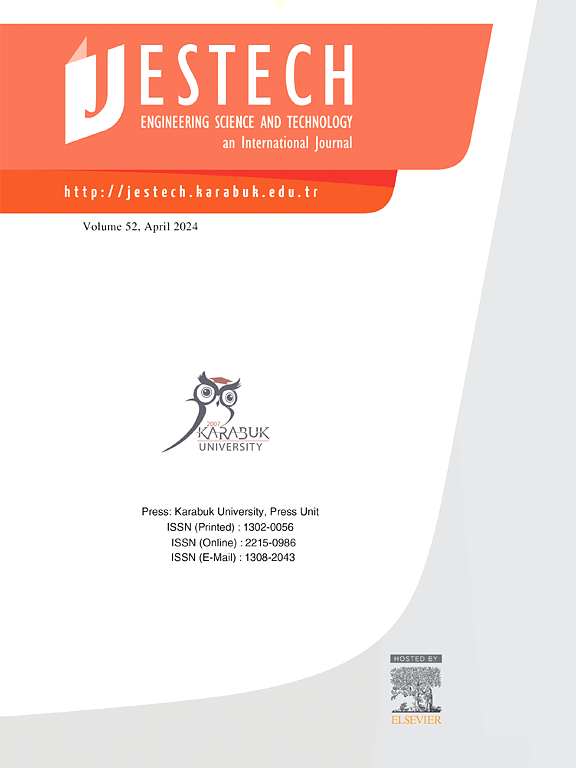Evaluation of a sustainable dye-exhausted resin regeneration method for cost-effective decolorization and detoxification of textile wastewater
IF 5.1
2区 工程技术
Q1 ENGINEERING, MULTIDISCIPLINARY
Engineering Science and Technology-An International Journal-Jestech
Pub Date : 2025-01-30
DOI:10.1016/j.jestch.2025.101973
引用次数: 0
Abstract
Despite the efficiency of the ion exchange (IEX) process in eliminating color and toxicity from textile wastewater, its extensive application is hindered by the challenges associated with recovering dye-exhausted resin using conventional regeneration methods. Thus, hazardous polymer-based decolorants are currently used to meet color standards and produce vast amounts of hazardous sludge. This study focuses on the hydrothermal alkaline regeneration (HTAR) method for regenerating exhausted strong-base anionic ion resin as an alternative to the hazardous decolorization method. It mainly emphasizes its application with trademarked regenerant (Veritas Regenerant®) after the resin was employed for decolorization and detoxification of biologically treated textile wastewater (BTTWW), aiming at sustainable treatment and reuse of such wastewater without producing hazardous sludge. The performance of the regenerated resin was assessed through various parameters, including toxicity (Microtox® test), color, chemical oxygen demand (COD), and total dissolved organic carbon (DOC). On average, the anionic IEX process achieved the removal of 96 % of color, 74 % of DOC, 43 % of COD, and 60 % of toxicity from BTTWW. Complete recovery of the resin was successfully attained using the HTAR method at 40 °C. Notably, the performance of the resin remained consistent over 50 multiple exhaustion/regeneration cycles, indicating the viability of HTAR for regenerating color-exhausted resin for repeated utilization in the treatment and reuse of biological textile wastewater. These results underscore the potential of trademarked regenerant in HTAR to improve the pre-treatment of textile wastewater before membrane wastewater reuse systems while also potentially reducing operational color removal costs in the textile sector, estimated at approximately 0.26–0.50 €/m3, to around 0.08 €/m3.

染料耗尽树脂可持续再生方法对纺织废水脱色脱毒的经济效益评价
尽管离子交换(IEX)工艺在去除纺织废水中的颜色和毒性方面效率很高,但使用传统再生方法回收染料耗尽的树脂所面临的挑战阻碍了其广泛应用。因此,危险的聚合物基脱色剂目前被用于满足颜色标准,并产生大量的有害污泥。本文研究了水热碱性再生(HTAR)法再生废强碱阴离子树脂,以替代有害的脱色方法。主要强调将该树脂用于生物处理纺织废水(BTTWW)脱色解毒后,与商标再生剂(Veritas regenerant®)结合使用,实现纺织废水的可持续处理和回用,不产生有害污泥。通过各种参数评估再生树脂的性能,包括毒性(Microtox®测试)、颜色、化学需氧量(COD)和总溶解有机碳(DOC)。平均而言,阴离子IEX工艺可以去除BTTWW中96%的颜色,74%的DOC, 43%的COD和60%的毒性。采用HTAR法在40℃下成功地实现了树脂的完全回收。值得注意的是,树脂的性能在50多次耗尽/再生循环中保持一致,表明HTAR再生颜色耗尽树脂用于生物纺织废水处理和回用的可行性。这些结果强调了HTAR中商标再生剂在改善膜废水回用系统前的纺织废水预处理方面的潜力,同时也有可能降低纺织行业的操作脱色成本,估计约为0.26-0.50欧元/立方米,约为0.08欧元/立方米。
本文章由计算机程序翻译,如有差异,请以英文原文为准。
求助全文
约1分钟内获得全文
求助全文
来源期刊

Engineering Science and Technology-An International Journal-Jestech
Materials Science-Electronic, Optical and Magnetic Materials
CiteScore
11.20
自引率
3.50%
发文量
153
审稿时长
22 days
期刊介绍:
Engineering Science and Technology, an International Journal (JESTECH) (formerly Technology), a peer-reviewed quarterly engineering journal, publishes both theoretical and experimental high quality papers of permanent interest, not previously published in journals, in the field of engineering and applied science which aims to promote the theory and practice of technology and engineering. In addition to peer-reviewed original research papers, the Editorial Board welcomes original research reports, state-of-the-art reviews and communications in the broadly defined field of engineering science and technology.
The scope of JESTECH includes a wide spectrum of subjects including:
-Electrical/Electronics and Computer Engineering (Biomedical Engineering and Instrumentation; Coding, Cryptography, and Information Protection; Communications, Networks, Mobile Computing and Distributed Systems; Compilers and Operating Systems; Computer Architecture, Parallel Processing, and Dependability; Computer Vision and Robotics; Control Theory; Electromagnetic Waves, Microwave Techniques and Antennas; Embedded Systems; Integrated Circuits, VLSI Design, Testing, and CAD; Microelectromechanical Systems; Microelectronics, and Electronic Devices and Circuits; Power, Energy and Energy Conversion Systems; Signal, Image, and Speech Processing)
-Mechanical and Civil Engineering (Automotive Technologies; Biomechanics; Construction Materials; Design and Manufacturing; Dynamics and Control; Energy Generation, Utilization, Conversion, and Storage; Fluid Mechanics and Hydraulics; Heat and Mass Transfer; Micro-Nano Sciences; Renewable and Sustainable Energy Technologies; Robotics and Mechatronics; Solid Mechanics and Structure; Thermal Sciences)
-Metallurgical and Materials Engineering (Advanced Materials Science; Biomaterials; Ceramic and Inorgnanic Materials; Electronic-Magnetic Materials; Energy and Environment; Materials Characterizastion; Metallurgy; Polymers and Nanocomposites)
 求助内容:
求助内容: 应助结果提醒方式:
应助结果提醒方式:


